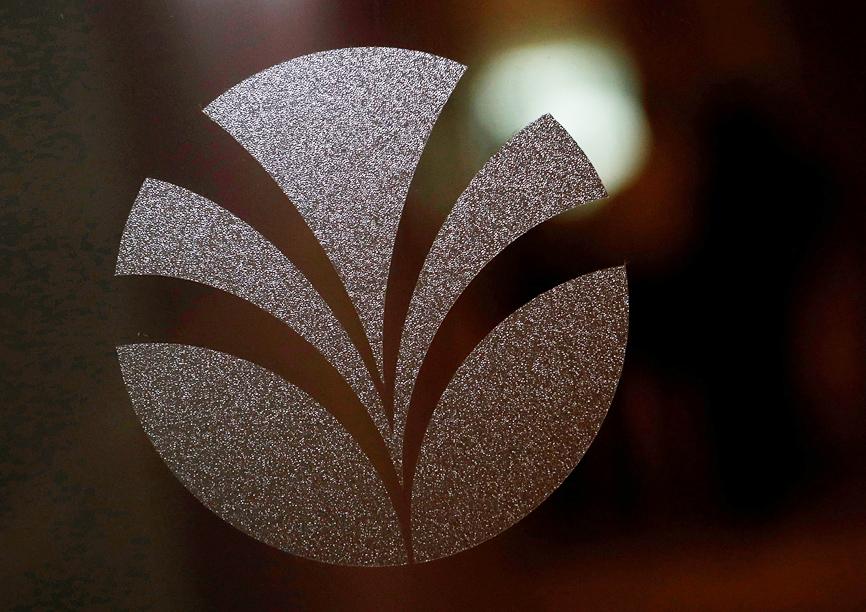Olam International Ltd, one of Asia’s biggest agricultural commodity traders and suppliers, has a target for its food ingredients unit to become part of the FTSE 100 after its initial public offering (IPO) in London.
The company, a major supplier of cocoa beans and products, green coffee and spices, expects the IPO to be “one of the bigger listings” on the London Stock Exchange (LSE) in several years, CEO Sunny Verghese said in an interview yesterday.
While the exact size is yet to be determined, Olam sees the unit potentially making it to the FTSE 100 share index, which consists of 100 London-listed companies with the highest market capitalization, Verghese said.

Photo: Reuters
Olam yesterday announced plans for a primary listing of its food ingredients business in London, while preparing for a concurrent secondary listing in Singapore, it said in a statement. The company also set a timeline to sell shares of another unit in an IPO as early as the second half of next year.
The moves follow a major overhaul of operations announced last year, which divided the Singapore-based group’s portfolio into two segments. One is Olam Food Ingredients (OFI), which consists of cocoa, coffee, edible nuts, spices and dairy, and offers products catering to the growing demand for healthier food.
The other is Olam Global Agri, which supplies food, feed and fiber with a focus on emerging markets in Asia and Africa. It includes the grains, animal feed, edible oils, rice, cotton and commodity financial services businesses.
“The primary listing on the LSE will give us access to London’s large and diverse investor base, with its deep and liquid capital markets, and enable us to benefit from its strong understanding of and research coverage across the food and beverage sector,” OFI chief executive officer A. Shekhar said. “The concurrent listing in Singapore will also enable us to retain our strong local shareholder base and further tap into growing investor appetite in Asia.”
The share sale is part of a strategic review published in January 2019, which aims to unlock and maximize long-term value. OFI purchased California-based spice manufacturer Olde Thompson for about US$950 million earlier this year. Olam announced a S$601.7 million (US$443 million) rights issue in June to cover partial repayment of a loan used to purchase Olde Thompson.
Olam yesterday also posted first-half earnings, showing that net profit rose 27 percent from a year earlier to S$421.5 million. Singaporean state investor Temasek Holdings Pte owns about 53 percent of the company, while Japanese trading house Mitsubishi Corp holds 15 percent following the rights issue.
Verghese said shareholders are supportive of Olam’s reorganization and would all stay on as investors.
The company plans to increase headcount given the need to duplicate some key functions across separate operating entities following the restructuring, he said.
Olam’s shares climbed as much as 4.2 percent in Singapore after the announcements, the biggest intraday gain since May. This compares with a 0.7 percent drop in the benchmark Straits Times Index. Still, the stock is little changed this year, even as agricultural commodity prices rallied.

Three experts in the high technology industry have said that US President Donald Trump’s pledge to impose higher tariffs on Taiwanese semiconductors is part of an effort to force Taiwan Semiconductor Manufacturing Co (TSMC, 台積電) to the negotiating table. In a speech to Republicans on Jan. 27, Trump said he intends to impose tariffs on Taiwan to bring chip production to the US. “The incentive is going to be they’re not going to want to pay a 25, 50 or even a 100 percent tax,” he said. Darson Chiu (邱達生), an economics professor at Taichung-based Tunghai University and director-general of

‘LEGACY CHIPS’: Chinese companies have dramatically increased mature chip production capacity, but the West’s drive for secure supply chains offers a lifeline for Taiwan When Powerchip Technology Corp (力晶科技) entered a deal with the eastern Chinese city of Hefei in 2015 to set up a new chip foundry, it hoped the move would help provide better access to the promising Chinese market. However, nine years later, that Chinese foundry, Nexchip Semiconductor Corp (合晶集成), has become one of its biggest rivals in the legacy chip space, leveraging steep discounts after Beijing’s localization call forced Powerchip to give up the once-lucrative business making integrated circuits for Chinese flat panels. Nexchip is among Chinese foundries quickly winning market share in the crucial US$56.3 billion industry of so-called legacy

Taiwan Semiconductor Manufacturing Co (TSMC, 台積電) yesterday held its first board of directors meeting in the US, at which it did not unveil any new US investments despite mounting tariff threats from US President Donald Trump. Trump has threatened to impose 100 percent tariffs on Taiwan-made chips, prompting market speculation that TSMC might consider boosting its chip capacity in the US or ramping up production of advanced chips such as those using a 2-nanometer technology process at its Arizona fabs ahead of schedule. Speculation also swirled that the chipmaker might consider building its own advanced packaging capacity in the US as part

A move by US President Donald Trump to slap a 25 percent tariff on all steel imports is expected to place Taiwan-made steel, which already has a 25 percent tariff, on an equal footing, the Taiwan Steel & Iron Industries Association said yesterday. Speaking with CNA, association chairman Hwang Chien-chih (黃建智) said such an equal footing is expected to boost Taiwan’s competitive edge against other countries in the US market, describing the tariffs as "positive" for Taiwanese steel exporters. On Monday, Trump signed two executive orders imposing the new metal tariffs on imported steel and aluminum with no exceptions and exemptions, effective